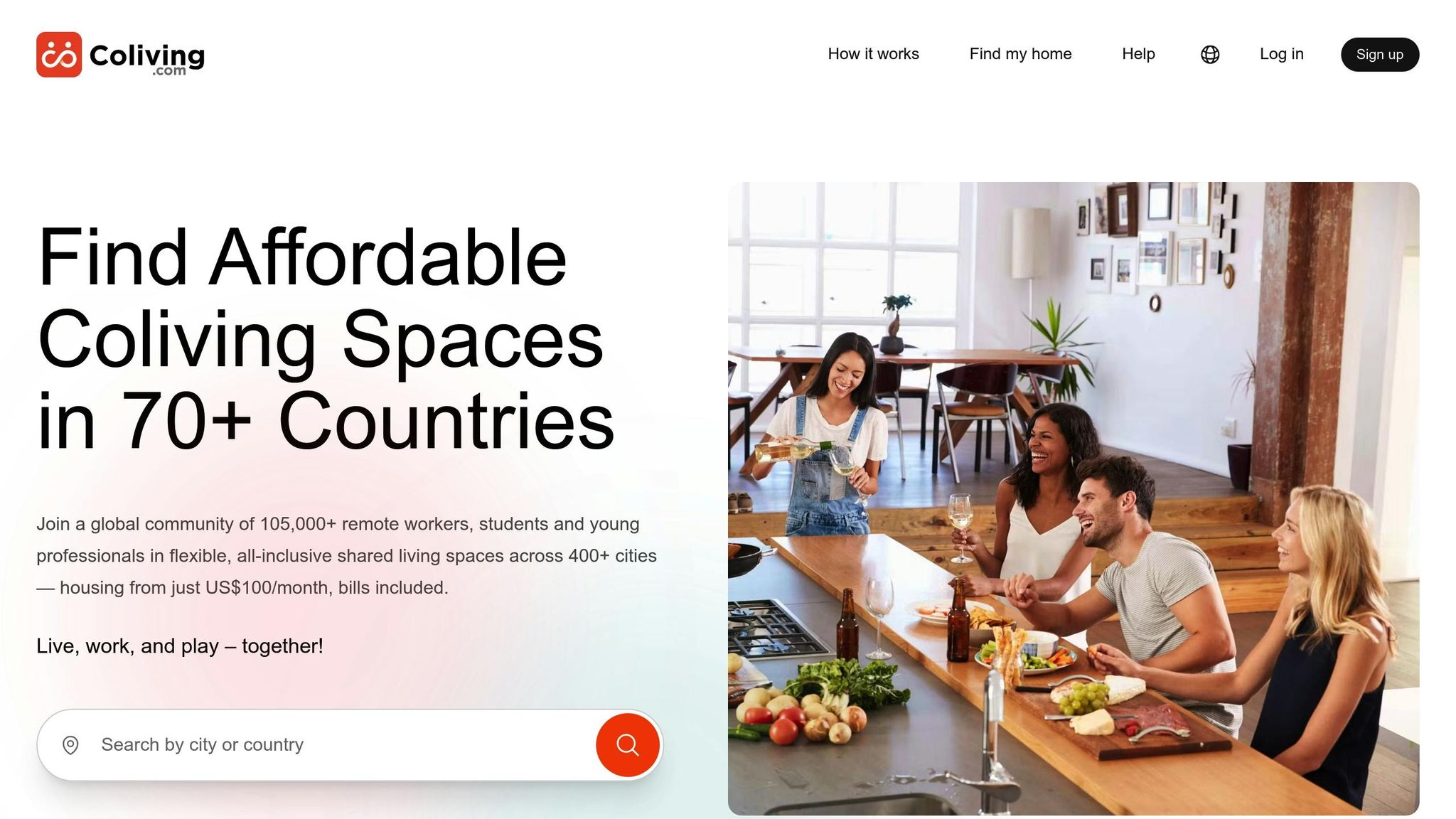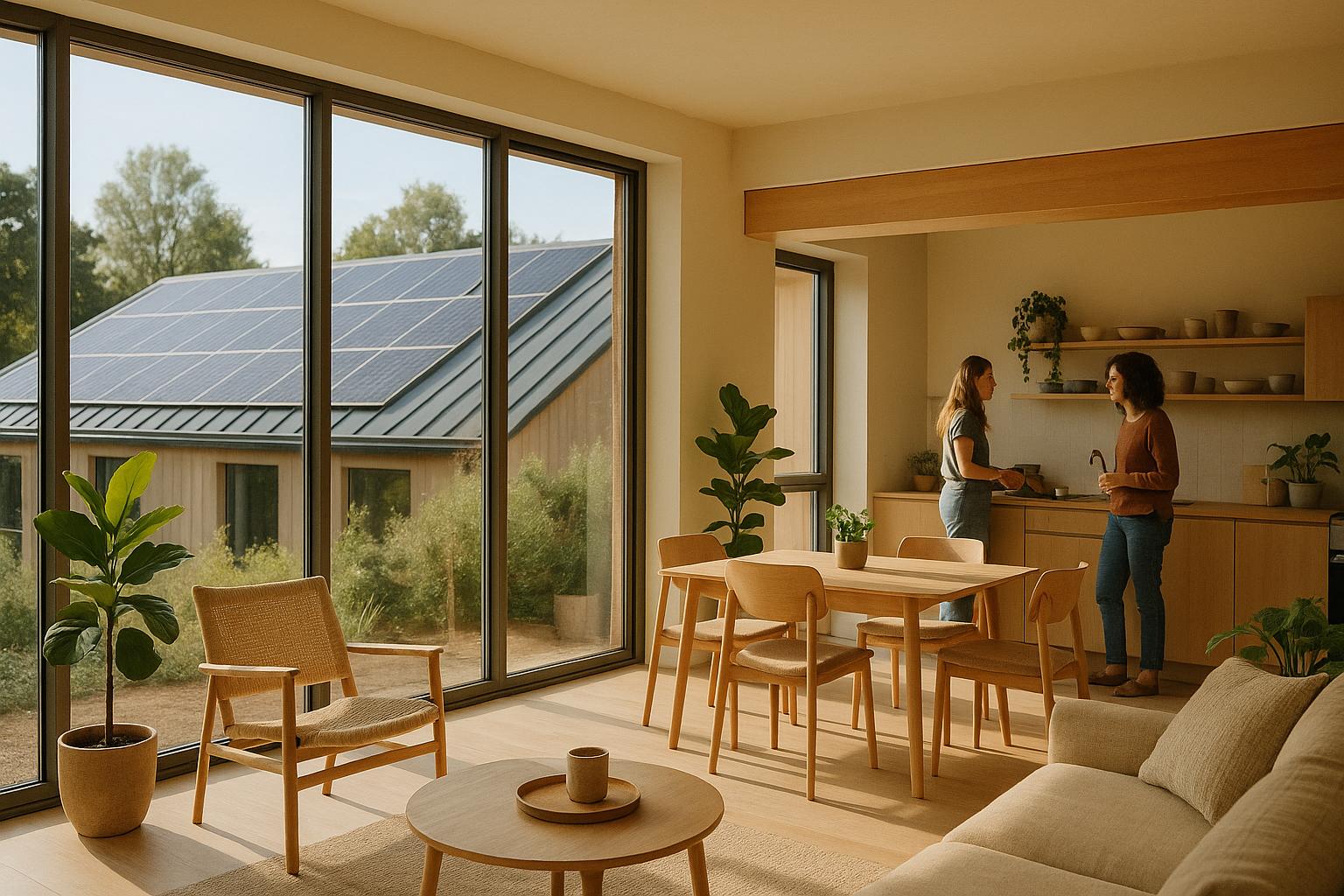Coliving is a modern housing setup where private bedrooms are paired with shared spaces like kitchens, living rooms, and coworking areas. It’s designed to balance privacy with community, offering benefits like cost savings, convenience, and a built-in social network. With all-inclusive pricing (covering rent, utilities, internet, and cleaning) and flexible lease terms, coliving is especially appealing to remote workers, young professionals, and those new to urban areas.
Key points:
- Private rooms with shared, fully furnished common spaces.
- All-inclusive pricing simplifies budgeting.
- Community-focused living with events and networking opportunities.
- Ideal for digital nomads, students, and professionals seeking flexibility and connection.
Coliving spaces vary from sleek urban buildings to cozy converted homes, with options tailored to specific lifestyles, such as entrepreneurial hubs or wellness-focused communities. Popular in cities like New York, San Francisco, and Los Angeles, coliving continues to grow as a flexible and affordable housing solution.
How Coliving Works
Coliving has gained popularity by blending smart design, simplified processes, and a focus on building community. It offers a housing option that’s both practical and socially engaging.
Structure of Coliving Spaces
At its core, coliving revolves around private rooms paired with shared amenities. Residents typically have their own bedrooms - personal spaces that often come furnished and, in some cases, include en-suite bathrooms. Shared areas like kitchens and living rooms are designed to encourage interaction and foster a sense of connection.
Coliving spaces often go beyond the basics, offering amenities that might otherwise be costly to access individually. These can include coworking spaces with high-speed internet, quiet areas for remote work, fitness rooms, rooftop terraces, game lounges, or even spaces dedicated to relaxation and mindfulness. Maintenance, cleaning of common areas, and facility operations are usually handled by the building management, freeing residents to focus on their personal and professional lives. This combination of thoughtful design and convenience makes coliving a seamless living experience.
Flexible and Simple Rental Process
One of the standout features of coliving is its straightforward rental process. Unlike traditional rentals that often involve piles of paperwork and separate bills for utilities, coliving simplifies everything with an all-inclusive monthly payment. This single fee typically covers rent, utilities, high-speed internet, cleaning services, and access to shared amenities, making budgeting much easier and avoiding surprise costs.
Flexible lease terms and digital applications make moving in a breeze. Prospective residents can browse rooms, submit applications, and even take virtual tours online. While background and income checks are part of the process, approvals are generally quicker than what you’d experience with traditional rentals.
The Role of Community in Coliving
Coliving isn’t just about shared spaces - it’s about creating a sense of community. Residents aren’t just neighbors; they’re encouraged to connect through organized events and shared experiences. These activities help build relationships and create a vibrant social environment.
Many coliving spaces employ community managers who play a key role in fostering these connections. They organize events, assist new residents in settling in, and address any concerns, ensuring a welcoming and supportive atmosphere. These events often lead to friendships, professional networking, and creative collaborations, making coliving more than just a place to live - it’s a lifestyle that caters to people seeking flexibility and meaningful connections.
Types of Coliving Spaces
Coliving spaces come in many shapes and sizes, catering to a range of lifestyles, budgets, and personal goals. Knowing the differences can help you find a setup that suits both your community-oriented spirit and individual needs.
Urban Coliving Buildings
Urban coliving buildings are sleek, purpose-built spaces designed specifically for shared living. These multi-story complexes, often located in major U.S. cities, combine private rooms with shared common areas like kitchens, lounges, and coworking spaces. Think of them as modern apartment buildings, but with a strong emphasis on community.
Private rooms in these buildings are typically furnished and come with essential amenities. Monthly rates usually bundle utilities, Wi-Fi, and even perks like cleaning services, making them a competitive alternative to traditional rentals. Beyond the practical benefits, these buildings foster social interaction. Many employ community managers who organize events like workshops, networking meetups, and social gatherings, making it easy for residents to connect and build relationships.
Converted Homes or Apartments
Converted homes or apartments offer a more intimate coliving experience. These are often existing houses, warehouses, or apartments that have been reimagined for shared living. Think historic brownstones, charming older homes, or spacious lofts, where the focus is on creating a cozy, home-like atmosphere.
These spaces usually house smaller groups of residents, which naturally encourages closer connections. While they may lack the extensive amenities of larger coliving buildings, they make up for it with character and a sense of warmth. Shared kitchens, living rooms, and other common spaces become the heart of the home, where residents bond over meals or casual conversations.
Themed or Purpose-Driven Communities
For those seeking more than just a place to live, themed or purpose-driven coliving spaces offer a unique opportunity to connect with like-minded individuals. These communities revolve around shared interests, careers, or lifestyles, creating a deeper sense of belonging.
For example, coliving spaces for entrepreneurs often provide networking opportunities, mentorship programs, and coworking spaces. Creative hubs cater to artists, writers, and designers, sometimes including studios or maker spaces. Student-focused coliving arrangements are designed with study areas and career resources, while digital nomad communities offer flexible living options and tailored experiences for remote workers.
The cost and level of commitment for these themed communities can vary, but the real draw is the curated environment. Living among people who share your passions or goals creates a built-in network for both professional growth and personal connection.
This wide range of coliving options highlights how flexible and diverse the concept can be, setting the stage for deeper insights into what features to prioritize when choosing the right setup for you.
Key Features and What to Look For
Finding the right coliving space can make or break your shared living experience. With so many choices out there, knowing what to prioritize will help you zero in on a space that suits your lifestyle and needs. Here's a breakdown of the most important features and factors to consider so you can make an informed decision.
Must-Have Features of Coliving Spaces
Start with the basics: fully furnished private rooms. Your room should be move-in ready, equipped with a comfortable bed, plenty of storage, a desk for work, and good lighting. The quality of furniture matters - flimsy or poorly assembled items can quickly turn into a headache.
High-speed Wi-Fi is non-negotiable, especially if you work remotely or run an online business. Make sure the space provides reliable internet throughout the building to avoid disruptions.
Look for all-inclusive pricing to simplify your budget. The best coliving spaces bundle essentials like rent, utilities, internet, and cleaning services into one monthly payment. Some even throw in perks like gym memberships or coworking access.
Well-designed common areas are the heart of any coliving community. These spaces should feel inviting and versatile, whether you're hosting a gathering or working quietly. If you're working from home, a dedicated coworking area with ergonomic furniture is a major plus.
Cleanliness is key, so check for professional cleaning services for shared spaces. Regular cleaning (weekly or bi-weekly) keeps kitchens, bathrooms, and other communal areas tidy and avoids awkward discussions about chores.
Factors to Consider When Choosing a Coliving Space
Physical amenities are just one side of the coin. The overall living environment plays an equally important role in your experience. Here are some additional factors to weigh:
Community culture shapes your day-to-day life. Some coliving spaces cater to young professionals in specific industries like tech or finance, while others attract artists, entrepreneurs, or students. Ask about the community's vibe and demographics to see if it aligns with your lifestyle.
Location convenience goes beyond proximity on a map. Think about commute times during rush hour and how close you’ll be to essentials like grocery stores, pharmacies, gyms, and entertainment spots. A cheaper rent might not be worth it if it adds hours to your daily routine.
Security measures are essential for peace of mind. Look for features like key fob or smartphone app entry, security cameras in common areas, and well-lit entrances. These systems not only protect residents but also make it easy to deactivate lost keys.
Noise policies and building design can make or break your comfort. Spaces with proper soundproofing and clear quiet hours (typically 10 PM to 8 AM) are ideal if you value a calm environment. Ask about the building’s construction - older buildings may lack sound insulation compared to newer, purpose-built coliving spaces.
Flexibility in lease terms is crucial if your plans might change. Month-to-month leases, while often more expensive, are great for digital nomads or those in transition. Avoid long-term commitments unless you’re confident about staying put.
Management responsiveness is a big deal when issues arise. Check online reviews to see how quickly maintenance requests are handled and how well management addresses resident concerns. A responsive team can save you a lot of stress.
Finally, review guest policies if you plan to host friends or family. Some spaces are more lenient with overnight guests, while others have stricter rules. Knowing these policies upfront can prevent conflicts and ensure the space aligns with your social habits.
Benefits and Challenges of Coliving
Coliving, like any housing setup, has its perks and downsides. Weighing both can help you decide if it aligns with your lifestyle and expectations.
Benefits of Coliving
Cost Savings
By sharing expenses like utilities and amenities, coliving often reduces the overall cost of living, especially in expensive urban areas.
Built-In Community
Living with like-minded individuals makes it easier to form personal and professional connections. It’s a ready-made social network.
Flexibility
Month-to-month leases give you the freedom to move quickly, whether for a new job or travel plans.
Reduced Household Responsibilities
With cleaning and maintenance handled by professionals, you’re free from the hassle of routine chores.
Access to Premium Amenities
Pooling resources allows access to features like rooftop decks, coworking spaces, and fitness centers that might be out of reach in a traditional rental.
Still, these benefits come with challenges that might not suit everyone.
Potential Challenges of Coliving
While coliving offers plenty of advantages, it’s not without its hurdles, which could affect your day-to-day life.
Limited Privacy
Shared spaces mean you’ll often interact with others, which can feel overwhelming if you’re used to more solitude.
Community Compatibility
Even with careful screening processes, not everyone’s habits or routines will align perfectly. Differences in cleanliness, schedules, or lifestyles can sometimes lead to tension.
Less Control Over Your Environment
In a shared setup, decisions about decor or space adjustments are often out of your hands.
Potential for Higher Costs
Despite shared expenses, the convenience and community aspects of coliving can sometimes mean higher costs per square foot, especially if private rooms are smaller.
Limited Long-Term Stability
High turnover rates in coliving spaces can make it harder to establish lasting relationships or maintain a consistent routine.
Comparison Table: Benefits vs. Challenges
| Benefit | Description | Potential Challenge | Description |
|---|---|---|---|
| Shared Expenses | Lowers individual costs by splitting utilities and amenities | Higher Costs per Square Foot | Smaller private spaces may result in higher costs in some markets |
| Built-In Community | Makes socializing and networking easier | Community Compatibility | Lifestyle or habit differences can sometimes create friction |
| Flexibility | Short-term leases allow for quick changes in living arrangements | Limited Long-Term Stability | High turnover can disrupt routines and make forming long-term bonds more difficult |
| Reduced Responsibilities | Professional cleaning and maintenance lessen daily chores | Less Control Over Environment | Personalizing or modifying shared spaces often requires group agreement |
| Premium Amenities | Shared costs provide access to features like gyms and coworking spaces | Limited Privacy | Shared areas and frequent interactions may reduce personal space |
Coliving Hubs and Trends in the United States
Let’s dive into some of the top coliving hotspots in the U.S. and the trends shaping this rapidly growing housing model. Across the country, coliving is redefining urban living by offering a mix of affordability, community, and flexibility.
Top U.S. Coliving Cities
Several major cities have emerged as key players in the coliving movement, each with unique dynamics driving demand:
- New York City: As one of the most expensive cities in the U.S., New York has become a prime market for coliving. These spaces provide a cost-effective and adaptable alternative for those navigating the high rents of the Big Apple.
- San Francisco and the Bay Area: Known for its tech-driven economy, this region has embraced coliving as a solution for professionals seeking flexible housing in a competitive market.
- Los Angeles: With its sprawling urban landscape, LA has seen a rise in coliving spaces designed to balance work, socializing, and convenience.
- Seattle: Home to a thriving tech sector and a vibrant economy, Seattle’s demand for flexible housing options has made it a standout coliving market.
Beyond these cities, Austin, Denver, Chicago, and Washington D.C. are also seeing growth in coliving spaces. The rise of remote work and changing lifestyle priorities are fueling demand in these emerging markets.
Emerging Trends in Coliving
Coliving continues to adapt to the needs of modern residents, with several trends shaping its evolution:
- Demographic Diversity: Coliving is no longer just for young professionals or students. Millennials, Gen Z, remote workers, and even some Gen X residents are joining these communities, drawn by the social and flexible living arrangements.
- Hybrid Work Influence: With many professionals splitting their time between remote and in-office work, short-term and flexible coliving options are becoming increasingly attractive compared to traditional leases.
- Focus on Wellness: Many coliving spaces now prioritize amenities that support both physical and mental health. From fitness facilities to communal areas designed for relaxation, wellness is becoming a central feature.
- Corporate Interest: Businesses are starting to explore coliving as a practical solution for housing employees temporarily, especially those relocating for work.
Coliving.com's Role in the U.S. Market

Platforms like Coliving.com are making it easier than ever to access these shared living options. With a presence in over 380 cities worldwide, including major U.S. metros, Coliving.com connects users to a vast network of coliving spaces.
Their straightforward pricing model - starting at $100/month - eliminates hidden fees and allows users to compare costs across neighborhoods. Flexible booking options cater to those seeking short-term or month-to-month stays, and the platform’s 100% online process removes traditional barriers like lengthy applications and large security deposits.
Coliving.com offers access to more than 38,000 rooms across 1,900 spaces, ranging from sleek urban high-rises to carefully repurposed residential buildings. Features like a money-back guarantee and simple cancellation policies provide added peace of mind for those exploring the coliving lifestyle.
Conclusion
Coliving is changing the way we think about housing, community, and urban life. By blending private living spaces with dynamic shared areas, it tackles key urban housing challenges while reimagining the concept of "home."
This approach offers practical solutions for modern living. Whether you're a remote worker hopping between cities, a recent graduate starting your career, or simply someone seeking stronger social connections, coliving provides convenience through all-inclusive pricing. Utilities, internet, and furnishings are bundled together, and shorter lease terms make it easier to adapt to life’s changes.
Beyond the practical perks, coliving fosters meaningful connections, helping to combat the isolation often felt in urban settings. These qualities are why coliving is becoming a cornerstone of modern city living.
The rise of coliving in major U.S. cities reflects how it meets both practical needs and shifting lifestyle trends.
Key Takeaways
- Affordability: Shared costs make coliving an economical choice.
- Flexibility: Shorter-term commitments allow for easier transitions.
- Community: Built-in social networks help create a sense of belonging.
Coliving spaces come in all shapes and sizes, from sleek urban high-rises to cozy converted homes and even themed communities, offering something for everyone. When exploring coliving options, consider factors like location, the quality of shared spaces, house rules, and the overall community vibe to find the right fit.
If you're curious about coliving, check out Coliving.com. With over 38,000 rooms across 1,900 spaces in more than 380 cities, the platform makes it easy to dive in. Their fully online process, money-back guarantee, and hassle-free cancellation let you explore coliving risk-free, with rates starting as low as $100 per month.
FAQs
What makes coliving different from traditional shared housing or having roommates?
Coliving offers a fresh take on shared living by focusing on community and convenience. Unlike traditional roommate setups, where you’re left to find housemates and manage expenses on your own, coliving provides professionally managed spaces. These setups typically include private rooms and shared common areas, all designed to promote interaction and connection among residents.
What makes coliving even more appealing is its all-inclusive pricing. Rent, utilities, internet, and even services like cleaning are bundled together, simplifying the experience. Many coliving spaces also offer flexible lease terms, making them a great option for those who value privacy, affordability, and the opportunity to connect with like-minded individuals - all without the usual headaches of traditional shared housing.
What should I look for in a coliving space to match my lifestyle?
When choosing a coliving space, it's essential to weigh factors like location, amenities, community vibe, and cost to find the right fit for your lifestyle. Look for spaces that provide shared perks like coworking areas, gyms, or regular social events that align with your daily habits and preferences.
Think about the kind of community atmosphere you want - whether that's a lively, collaborative environment or something quieter and more private. Make sure the space aligns with your professional goals, personal hobbies, and, of course, your budget. Picking a coliving space that matches your needs can make the experience of shared living more enjoyable and rewarding.
What are some potential challenges of coliving that residents should consider?
While coliving has its perks, it’s not without its challenges. One of the main concerns is privacy - shared spaces like kitchens, bathrooms, and living areas mean less personal space. Additionally, differences in lifestyles and habits can sometimes cause friction, particularly when it comes to shared responsibilities or respecting personal boundaries.
The good news? These challenges can often be managed with open communication and mutual respect. Picking a coliving space that matches your values and preferences can also go a long way in ensuring a smoother, more enjoyable experience with your housemates.






